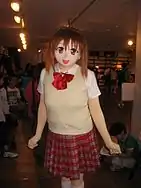
Animegao kigurumi is a type of masked cosplay that has its origins in the official stage shows of various Japanese anime but has also been adapted by hobbyists. In Japan, most performers refer to this kind of cosplay as 'kigurumi' (着ぐるみ) instead of 'animegao' (アニメ顔, meaning "anime face"), which has been used overseas in order to differentiate the cosplay from the onesies sharing the same name. The term 'doller' had also been used when referring to kigurumi cosplayers, but today mainly refers to BJD-styled masked cosplays. Although kigurumi remains a minor part of Japan’s cosplay scene, it began attracting overseas attention in North America and Europe around 2005.[1]
Practice of animegao kigurumi
As with other kinds of cosplay, many hobbyists have costumes of established characters from games or animations. The characters are usually female, and commonly human, although kigurumi characters of other species and genders do exist, including male (such as Kenshin Himura from Rurouni Kenshin), mechanical (such as Gundam Wing), elfin (such as Deedlit or Pirotess from Lodoss), and demonic (such as Inuyasha from the manga of the same name). Some kigurumi are original characters created by the performer. Wearing kigurumi is not restricted to one gender.[2][3]
By wearing a body suit and mask, kigurumi cosplayers are able to closer resemble the characters with high accuracy,[2][3] especially in the case of anime, anthro, or otherwise highly stylised characters. In kigurumi, the performers wear a plastic mask that was created by either molding or 3D printing and a matching flesh-coloured body suit (a zentai suit known as a hadatai). The body suit allows them less-detailed skin features, on the level of animated characters, and the mask allows a similar level of facial features.[1]
Some hobbyists obtain masks from established hobbyist mask studios. As of 2018, there are six mask studios locations in Japan, as well as in Taiwan and the United States.[4] Major production examples include a Japanese studio that takes orders for customized masks with wig and eye parts based on studio's original designs for over 130,000 yen (about US$1,182), and a Taiwanese studio that takes orders for fully customized masks for over 131,000 yen (about US$1,190).[4]. The average price of a mask produced by a mask studio is between 100,000 and 200,000 yen (about between US$910 and US$1,819).[4]
 This exemplary kigurumi leaves no part of their skin exposed.
This exemplary kigurumi leaves no part of their skin exposed. Animegao performers at Anime North.
Animegao performers at Anime North..jpg.webp) Kigurumi of HeartCatch PreCure! characters.
Kigurumi of HeartCatch PreCure! characters.
Media coverage
While kigurumi is largely used in stage shows and by hobbyists, it has extended into the acts of other performers. DJ Minami Momochi performs in such an outfit, American photographer Laurie Simmons featured them in a photo series,[5] and Japanese fashion model Lulu Hashimoto incorporates them in her outfits.[6] Kigurumi cafes have also operated in Japan, where waitresses are dressed in costume.[7][8] Some kigurumi performers were also featured in an Episode of a Netflix series "Midnight Asia"
See also
References
- 1 2 Vidani, Peter. "Animegao FAQ". animegao.tumblr.com. Retrieved 2017-07-10.
- 1 2 Lunair, Iliana (12 January 2020). "Ausstellung in Tokyo entführt in die Welt der Kigurumi-Masken". Sumikai (in German). Retrieved 18 June 2020.
- 1 2 "Hyokkame Solo Exhibition: Discover The Surreal and Kawaii World of Artistic Kigurumi Masks". grape. 11 January 2020. Retrieved 18 June 2020.
- 1 2 3 Jibiki Haruka,Sugiura Kazunori (2018). "アニメ顔着ぐるみマスク制作マッチングサービスの構築:マスク受注販売事業「キグルミ屋」の活動を通じて" [Construction of a matching service for animegao-kigurumi mask production : through the activities of mask order-to-sales business "Kigurumi-Ya"]. KeiO Associated Repository of Academic resources(KOARA) (in Japanese).
- ↑ "Laurie Simmons talks about her MCA photography show and how daughter Lena Dunham helped her explain her work". Chicago Tribune. 27 February 2019.
- ↑ "Meet Lulu Hashimoto, the 'living doll' fashion model". Reuters. 24 August 2017.
- ↑ "Garçonetes usam cabeças gigantes de pelúcia em bar no Japão". Galileu. Editora Globo S/A. 2 November 2012. Retrieved 3 April 2019.
- ↑ "秋葉原に「美少女着ぐるみカフェ」-2.5次元少女が身振り手振りで意思疎通" [Girl kigurumi cafe at Akihabara - 2.5D girl communicate through gesture] (in Japanese). Akiba Keizai Shimbun. February 2, 2010.